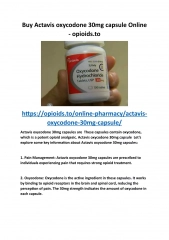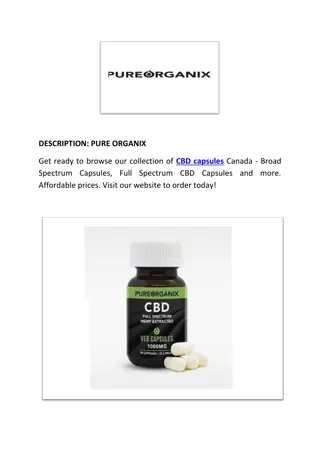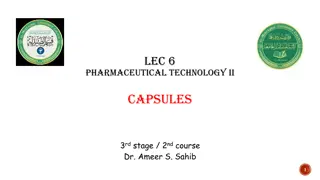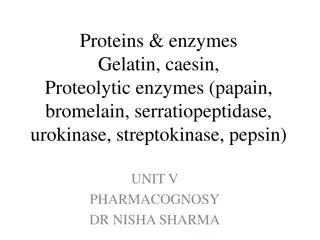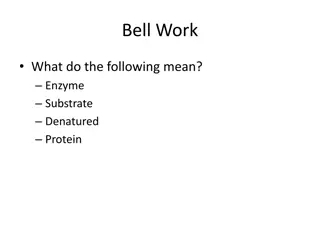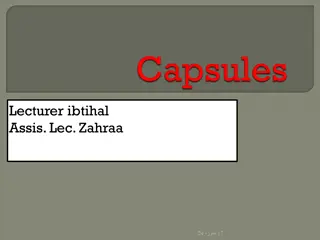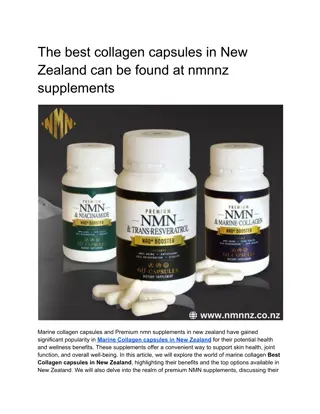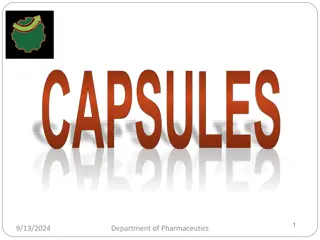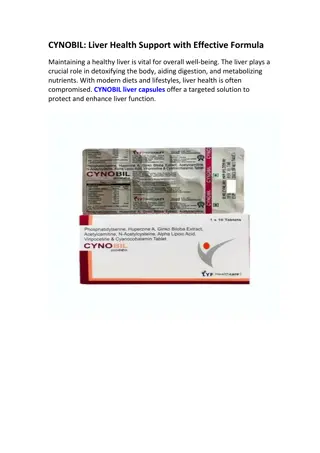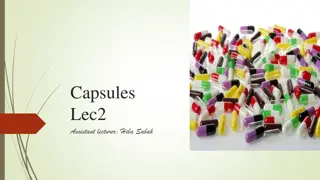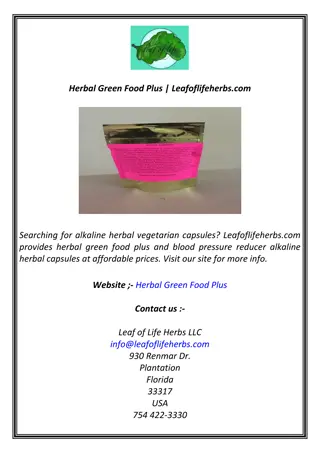Understanding Soft Gelatin Capsules and Their Advantages
Soft gelatin capsules are one-piece forms enclosing liquid or semi-liquid fill, offering advantages such as improved bioavailability, enhanced drug stability, and easy swallowability. They come with unique features like diverse colors, sizes, and shapes. Despite their benefits, they have limitations such as higher manufacturing costs compared to tablets. Differentiating between hard and soft gelatin capsules based on criteria like shell plasticization, moisture content, sizes, and closure methods is crucial. Commonly used capsule sizes include Oblong-20minim and Oval-16minim. Additional components in gelatin mass play important roles in capsule production and properties.
Download Presentation

Please find below an Image/Link to download the presentation.
The content on the website is provided AS IS for your information and personal use only. It may not be sold, licensed, or shared on other websites without obtaining consent from the author. Download presentation by click this link. If you encounter any issues during the download, it is possible that the publisher has removed the file from their server.
E N D
Presentation Transcript
SOFT GELATIN CAPSULES SOFT GELATIN CAPSULES Definition: Soft Gelatin Capsules are one-piece forms that encase a predetermined dose of liquid or semi liquid fill. Filled and hermetically sealed in a single operation Definition: 2
ADVANTAGES Improved bioavailability Enhanced drug stability Superior patient compliance Product differentiation by colour, size and shape Portability and easy to swallow Bad taste masking Uniformity and precision dosage ADVANTAGES: : 3
LIMITATIONS LIMITATIONS Equipment Higher manufacturing cost as compared to tablets 4
Hard Vs soft gelatin Capsules Hard Vs soft gelatin Capsules Criteria Criteria Hard Gelatin Capsules Hard Gelatin Capsules Soft Gelatin Capsules Soft Gelatin Capsules Shell Less or not plasticized Plasticized (glycerin, propylene glycol, sorbitol) 6-10% Moisture 12-16% Sizes and Shapes Limited Two-piece One-piece Content Usually dry solids Usually liquids or suspensions (dry solids possible) Manufacture Shells made in one operation and filled in a separate process Formed/filled in one operation Closure Traditional friction-fit; mechanical interlock Hermetically sealed (inherent) 5
FREQUENTLY USED CAPSULE SIZES Oblong-20minim Oval-16minim Round-9minim 6
Additional components of gelatin mass CATEGORY I Ingredient purpose glycerin, propylene glycol, sorbitol Parabens Plasticized Preservatives Water soluble dyes,lakes,vegetable colors Colorants Titanium dioxide Opacifier Essential oils Odor & taste Ethyl vanillin Odor and taste 8
Category II Ingredient Purpose Sugar(sucrose) Chewable shell and taste Aids solubility,reduces adehyde tanning of gelatin Fumaric acid 9
Source and types Source and types Type Source Source Isoelectric pH 9 Precursor treatment Acidic hydrolysis alkaline hydrolysis Acid character Type-A Pork skin Plasticity & clarity Tough film Type-B Animal bones 4.7 Acid-bone Bone 5.5-6.0 Intermediate film character. 10
Importance of plasticizers Importance of plasticizers: Plasticizer softness Determines disintegration and dissolution characters Must be compatible with fill formulation with minimum migration. 11
WATER: WATER: To ensure proper processing during gel preparation and soft gel encapsulation. Excess-capsules become soft and fuse Insufficient-hard and embrittle Equilibrium moisture content 6-10%w/w 12
COLORS An important aspect The color of the capsule shell should never be lighter in hue than capsulated material. Test for any reaction with the compound Dark spots with iron compounds COLORS: Clear colors clear type fill Opaque suspensions Titanium dioxide- As an opaquant and also to protect light sensitive ingredients In combination with different dyes produces different colors FD&C,D&C approved colors must be used 13
PRESERVATIVES PRESERVATIVES Microbial growth occurs due to presence of moisture. Examples: Methyl paraben Propyl paraben Humectants-glycerin 14
FILL FORMULATION FILL FORMULATION: To dispense active compounds formulated as Liquids Semisolids Suspensions Micro emulsion preconcentrate(nanoemulsions) Dry powders They are formulated such that (i) Smallest possible capsule consistent with maximum amount of ingredient and it is physically stable. (ii) Therapeutically effective (iii)Production efficiency 15
Liquids: Liquids: Determine the solubility of drug in range of pharmaceutically acceptable solvents. Water-miscible liquids: oPEG-400 oPolysorbates(non-ionic surfactants) o5-10% of propylene glycol, ethanol, glycerin Water-immiscible liquids: oVegetable oils oAliphatic & Aromatic chlorinated hydrocarbons oEsters oEthers 16
Liquids which can not be incorporated Liquids which can not be incorporated: oWater-in more than 5% of total formulation oEthyl alcohol oAldehydes oLiquids with extremes of pH 17
METHODS OF MANUFACTURE: 1.PLATE PRESS METHOD METHODS OF MANUFACTURE: 1.PLATE PRESS METHOD: Semi-automatic batch process Gelatin sheets placed on a mold, liquid medication is evenly poured and distributed on it. A second sheet of gelatin is carefully is placed on the top of the medication. Apply pressure to the mold to form a fill and sealed capsule simultaneously. 18
2.ROTARY DIE PROCESS Patented by Robert.P.Scherer in 1933 Principle: Two independent processes take place, often simultaneously,yielding two different materials.Both are united in the encapsulation process that produces wet soft gels. https://www.youtube.com/watch?v=pu9bvGlCxV c 2.ROTARY DIE PROCESS 19
Encapsulation Process Gelatin ribbons are brought together and the medicine is injected from the segment(S) into the die pocket from the pump(P). The necessary temperature for sealing is provided by the segment(S) and pressure provided by the die rolls(D). Encapsulation Process 21
Typical parts of the machine 01. Spreader Box 02. Cooling Drum 03. Oil Lubrication Roller 04. Gelatin Ribbon Guide Roller 05. Die Roll 06. Injection Wedge 07. Capsule Stripper 08. Conveyor 09. Medicine Filling Hopper 10. Medicine Filling Pump Typical parts of the machine: 22
Injection segment Die rolls Distribution plate Change gear 24
The soft gelatin capsule encapsulation machine wedge heater/ heating element is very important for making good quality softgels Spreader box 25
Drying: Tumble dryer Tray drying Moisture content-toluene distillation method Bulk holding container Tray dryer Washing Offline printing Inspecting packaging 26
Product quality considerations Final product testing Microbiological testing Assay and identity of activities Physical appearance Fill weight Dissolution & disintegration Dosage uniformity Product quality considerations: 27


